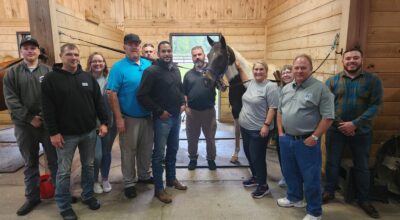The world comes to the Foothills
Published 4:43 pm Thursday, December 28, 2017

- Tryon International Equestrian Center Photo by Erik Olsen Pictures
The world will be coming to Tryon in fall of 2018 – the equestrian world that is. Next September the world’s leading horses and riders will gather at the Tryon International Equestrian Center (TIEC) for the World Equestrian Games (WEG).
From September 10 – 23 international horses and riders will vie for top honors in eight of the ten different equestrian sports recognized by the Fédération Equestre Internationale (FEI). WEG was started in 1990 to allow riders to compete in one location rather than in ten different individual competitions at as many different locations around the world.
WEG takes place every four years opposite of the Olympics and carries many of the Olympic traditions. Originally the Olympic equestrian sports were designed as a three-day-event type competition (also called combined training) that consisted of dressage, stadium jumping and cross-country.
In addition to the original three-day event type competitions, today’s WEG competitions include driving, vaulting, reining, para-equestrian and endurance riding. The two other disciplines, recognized by the FEI, that hold their competitions separately are horseball and tent pegging.
Horseball is a mounted sport that looks like a combination of polo, rugby and basketball. Tent pegging is a cavalry sport in which the riders use edged weapons such as a lance, sword or sabre to either retrieve objects from the ground or slash and cut objects mounted on a post.
When equestrian sports were added to the modern Olympic games in 1900, the cavalry was considered the source of the best horsemen in most countries. Therefore the Olympic equestrian sports turned to the cavalry for a method of testing horse and rider. Modern cavalry troopers had to be able to cover long distances, often over rough terrain and jumps. Once the horses and riders arrived at their destination, they would frequently go into a battle in which perfect, split second precision communication and responses meant life or death.
The horses had to be strong, agile and responsive to the riders’ most subtle signals and be able to make quick, agile movements in high stress situations. Such movements would often be a flat out gallop for several yards, then a quick halt, spin 180 degrees, take off a gallop, stop and turn again. The horses had to be able to move sideways, gallop forward in a split second and stop immediately. At times cavalry horses had to jump high fences, hedges, walls or even wagons or cannons under battle conditions.
The three-day event or combined training type competition involving dressage, stadium jumping and cross-country was designed to test these skills in the cavalry trooper and his horse. The dressage part of the three-day or combined training competition tests the horse’s agility, strength, precision, suppleness and response to the rider. Stadium jumping (known today as show jumping) tests the horse’s and rider’s ability to jump high jumps, at speed in tight, close quarters. The cross-country portion of the test determined whether the horse and rider had the skills and endurance to cover long distances, sometimes at speed, over difficult terrain and natural fences.
It is from this tradition that the equestrian Olympic competition, and later the World Equestrian Games were born. Until 1952 the Olympics opened the equestrian competition only to male commissioned military officers, and “gentlemen.” In 1952 women were allowed to begin competing in dressage. In 1956 women were allowed to compete in the jumping competition, but it was not until 1964 that women were allowed to ride in the cross-country competition. Today the equestrian sports are the only Olympic level competition in which men and women compete with and directly against one another.
The foothills area has its own historic connections to Olympic level equestrian sports. In 1956, the U.S. Olympic Equestrian Team trained in Tyron. Now, 62 years later, the World Equestrian Games bring Olympic level horsemen, and now women, back to the area. •
Over the next several issues, Foothills magazine will describe the different events that are included in WEG. We will begin next month with a description of the beautiful ballet between horse and rider known as dressage. Our story will include a history of the art, an explanation of the different movements and how something that looks so easy and simple on the outside can thrill and inspire riders of all levels.
Catherine Hunter’s journalism career spans 20 years of writing for newspapers and magazines, including The Chronicle of the Horse, The Western Horseman, the Tryon Daily Bulletin and Foothills Magazine. In 2000, Hunter received a South Carolina Press Association award for reporting in depth. She is the author of “Sacred Connections Horsemanship: Empowering Horse and Rider through Chakra Energy.” Email her at catherine.hunter@tryondailybulletin.com.





